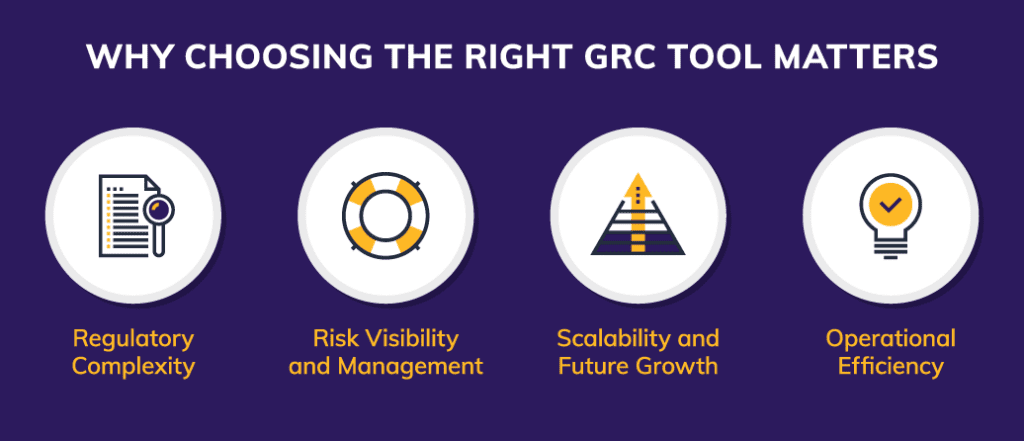Learn about key considerations when selecting a GRC tool. We aim to help you choose the right tool to boost compliance, operational efficiency, and long-term success while avoiding costly compliance pitfalls.
There’s a lot at stake when choosing the right governance, risk and compliance (GRC) tool. The wrong one can lead to serious compliance issues and inefficiencies that can hamper your team’s productivity.
Intensifying regulatory demands further complicate the decision-making process because you have to meet compliance standards without sacrificing the operational agility of your organization.
By using this guide, you can ensure you get the best GRC tool for your organization, both in terms of maintaining efficient operations and aligning with compliance requirements.
Why Choosing the Right GRC Tool Matters
GRC tools make it easier for companies to establish and enforce internal and external governance requirements. They also serve as a risk-reduction tool by giving you visibility into your GRC risks and tools for limiting them.
Some of the most compelling reasons to match the right tool with your organization include:
- Regulatory complexity. Standards such as NIST, HIPAA, and ISO 27001 come with an intricate array of requirements. The right GRC tool streamlines your compliance management process by clarifying which steps you need to take, when, and how.
- Risk visibility and management. The best GRC tool for your organization will provide real-time risk insights that pinpoint when you’re in danger of running into a compliance issue. The most effective tools come with dashboards, risk mitigation mechanisms, and automated alerts—all of which work together to shrink your risk.
- Scalability and future growth. Your compliance needs may change depending on how your business grows, how your digital infrastructure evolves, and the kinds of data you have to manage. The right tool should be flexible enough to handle these kinds of changes.
- Operational efficiency. Staying on top of compliance minutiae can involve a lot of manual, time-consuming work. Therefore, you want a GRC tool that automatically schedules audits and collects evidence of compliance. It should also automatically pull data from your security and information event management (SIEM) solution to reduce the chances of human error. When used in combination, these features make your compliance management system more efficient.
Questions to Ask When Vetting a GRC Tool
Here are some key questions to simplify the process of choosing the best GRC tool for your organization. Their answers can make it easy to see whether the tools you’re considering will be up to the task.
Compliance Framework Support
Does the tool align with your industry’s regulations (PCI DSS, HIPAA, GDPR, NIST, CMMC)?
While many GRC tools support multiple frameworks, you’ll want to ensure the ones you’re considering specifically address the regulations that apply to your industry.
For example, some tools come with prebuilt workflows that manage requests for privacy rights according to specific regulations, such as the European Union’s General Data Protection Regulation (GDPR). This way, you don’t have to try to build a privacy rights request system from scratch.
Can the tool adapt to compliance requirements as they evolve?
Your tool should incorporate compliance changes automatically with updates. If this isn’t a service the software provider makes available, they should at least provide you with step-by-step guidance to make sure a new requirement doesn’t render your current compliance management system obsolete.
Risk Management Capabilities
Does it provide real-time risk monitoring, incident tracking, and automated risk assessments?
Your solution should come with a dashboard that finds risks in real time, as well as an automated risk assessment and alert system. For instance, some solutions track security risks in real time and outline their operational impacts.
Can it map risks to business impact for better decision-making?
The right GRC tool can make it easier to see how risks can affect your business by clearly delineating the impact of each risk on your operations or bottom line.
For instance, some tools can tell you how much money certain kinds of data breaches may cost your organization. With this data in hand, you can decide which risks to prioritize as you build your mitigation system.
Automation and Workflow Integration
Can it automate compliance audits, policy reviews, and risk assessments to reduce manual effort?
There’s a lot to keep track of as you maintain compliance, so you need a GRC solution that automates as much of the legwork as possible. For example, there are tools that automatically tell you which elements of your ecosystem to review and when so you’re ready well before it comes time for an audit.
Does it support automated alerts and task assignments for compliance violations?
GRC tools should provide alerts in real time whenever there’s been a breach of policy. For instance, your security team can get an alert whenever an incident occurs. Your data management team can also receive an alert whenever there’s a change to a database that contains sensitive customer data.
User-Friendly Interface and Customization
Is the tool intuitive for users at all levels—analysts, directors, and the C-suite? Across security, compliance, and executive teams?
Your GRC tool should be accessible to a range of stakeholders. Some tools, for instance, come with easy-to-understand data flow maps that show where data originates and where it goes, such as on-premises and cloud storage resources and enterprise resource planning and financial apps.
Can workflows, dashboards, and reports be customized to your organization’s needs?
Ideally, each employee who deals with GRC management should be able to set up their dashboard.
For instance, a pharmaceutical company may have a scientist who needs to route patient identification information to an encrypted database. However, that employee may not have to follow the same data deletion requirements as those in marketing who manage a customer relationship management tool.
Every employee should be able to craft a workflow that meets their needs.
Third-Party and Vendor Risk Management
Does it assess and track third-party compliance risks?
Some vendors may have a history of breaches. Others may reveal in a risk survey that they don’t know which encryption protocols they have in place in their on-premises storage systems. Your GRC tool should make it easy to assess and track these risks.
Can it automate vendor risk questionnaires and security assessments?
Some tools come with premade risk questionnaires and assessments. Others may use generative artificial intelligence (AI) or automation to build them for you. You’ll want to see which features each choice offers before committing.
Audit and Reporting Capabilities
Does the tool provide real-time audit trails, simplify audit prep, track compliance status, and easily generate reports?
Tools that provide real-time audit trails make it easier for auditors to provide evidence of what they’ve checked and discovered. This feature also benefits compliance tracking because it automatically produces reports regarding how your organization measures up to each applicable standard.
Integration With Existing Security and IT Systems
Can it seamlessly integrate with SIEM, IAM, cloud security, and enterprise risk management tools through APIs or manual integrations?
Ideally, you want a GRC tool that uses an application programming interface (API) to integrate with your existing SIEM, identity and access management (IAM), security, and risk management solutions. That way, you don’t have to manually copy and paste data from each system to assess risk.
If there’s no API available, the provider should make it clear how to manually set up an integration with the apps and systems you depend on.
Scalability and Flexibility
Can it handle growth in users, regulatory complexity, and business expansion?
An acquisition or merger, changing regulations, and business growth can easily throw a wrench in your compliance management system if you don’t have a flexible tool. Ask each provider specific questions based on scenarios, such as adding another business unit, to see how their solution can adjust.
Does it offer modular features so you can scale as compliance needs evolve?
You may need to add a different type of compliance management, and your tool should accommodate this.
For example, you may start working with a third-party vendor that may introduce a data security risk because you have to give them access to your list of customers. If your tool has a third-party risk management module, you can just add the module to your existing system.
Cost vs. Value
Is the pricing structure transparent, flexible, and based on organizational size?
You should know what happens to your pricing if your organization grows or adds another office. Some providers may be more flexible than others, willing to adjust pricing to maintain your business. Others may hit you with a significantly larger bill just because you add a few more users.
Does it offer value beyond compliance, such as risk insights and operational efficiencies?
Fortunately, some of the leading GRC tools can do more than simply track compliance issues.
Some tools can aggregate data from audits and cybersecurity logs and then use AI-powered analytics to detect patterns across your organization. For instance, they can detect a rise in the frequency of distributed denial-of-service (DDoS) attacks.
Selecting a GRC Tool for Long-Term Success
The right GRC tool should streamline your compliance process and double as a security and risk management tool. It’s important to systematically evaluate each option and pay attention to its functionality, reporting, automation, integration, and scalability before choosing one over the rest.
Start evaluating GRC solutions today to find the best fit for your compliance and risk needs.
You know you need to protect your brand and financial stability by prioritizing cybersecurity. But do you know where to start? Our Cybersecurity team is ready to help you focus on everything from strategy development to penetration testing. Let’s talk



